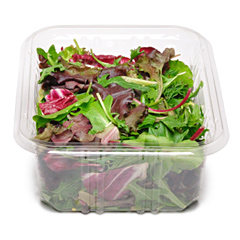
Leafy greens usually have crisp green leaves and stalks, and should be eaten raw or lightly cooked to preserve the nutrients.
Popular types of leafy greens include:
- lettuce
- arugula
- bok choy
- spinach
Because leafy greens are often eaten raw, they can be a source of food poisoning.
The Canadian Food Inspection Agency (CFIA) released the results of a survey (starting from 2008/2009) of 4,250 domestic and imported, whole and fresh-cut fresh leafy vegetable samples in the Canadian market for Salmonella, E. coli O157:H7, E. coli O157:NM, generic E. coli, and Listeria monocytogenes.
- The 2009/2010 study deemed 12 samples to be “unsatisfactory” due to the presence of Salmonella, Listeria monocytogenes, and/or high levels of generic E. coli.
- None of the samples were found to be positive for E. coli O157:H7 or E. coli O157:NM.
- All unsatisfactory samples were subject to food safety investigations and further directed sampling.
- As a result of this survey, two products were recalled.
- No illnesses were associated with consumption of any of the products.
- The recent, overall finding of this survey is that more than 99.9 per cent of leafy green vegetable samples had no detectable levels of bacterial pathogens and were safe to consume.
- Therefore, the vast majority of leafy green vegetables in the Canadian market are produced and handled under good agricultural and manufacturing practices.
- However, vegetable contamination with E. coli, Listeria or Salmonella could sporadically occur.
During the five-year plan, over 10,000 leafy vegetable samples have been collected and tested for the presence of pathogens.
- Further results will be released as lab tests are analyzed.
Consumers should follow these safety tips when choosing to purchase and consume leafy green vegetables at Healthy Canadians.
NEWS RELEASE
Over 99.9% of fresh leafy green vegetables tested had no detectable pathogens
CFIA tests over 4,000 samples
April 11, 2014 – Ottawa, ON – Canadian Food Inspection Agency
As part of the Canadian Food Inspection Agency’s (CFIA) routine testing of various food products, a survey released today found that more than 99.9 per cent of leafy green vegetable samples had no detectable levels of bacterial pathogens and were safe to consume.
As part of a five-year microbiological plan that began in 2008/2009, the CFIA analyzed a total of 4,250 domestic and imported, whole and fresh-cut fresh leafy vegetable samples available in the Canadian market for Salmonella, E. coli O157:H7, E. coli O157:NM and generic E. coli. The fresh-cut samples were also tested for Listeria monocytogenes.
The 2009/2010 study deemed 12 samples to be “unsatisfactory” due to the presence of Salmonella, Listeria monocytogenes, and/or high levels of generic E. coli. None of the samples were found to be positive for E. coli O157:H7 or E. coli O157:NM.
All unsatisfactory samples were subject to food safety investigations and further directed sampling. As a result of this survey, two products were recalled. No illnesses were associated with consumption of any of the products.
The overall finding of this survey suggests that the vast majority of leafy green vegetables in the Canadian market are produced and handled under good agricultural and manufacturing practices. However, vegetable contamination with E. coli, Listeria or Salmonella could sporadically occur. Consumers should follow these safety tips when choosing to purchase and consume leafy green vegetables at Healthy Canadians.
Quick Facts
- Salmonella, Listeria monocytogenes, E. coli O157:H7 and E. coli NM are bacteria that can cause foodborne illness. Fresh produce can occasionally become contaminated with these harmful bacteria at various stages of their production. Generic E. coli are harmless bacteria found in human and animal intestines. Its presence in food is often used as an indicator of faecal contamination, which can suggest inadequate agricultural and/or sanitation practices along the food production chain.
- In recent years, leafy green vegetables have been reported to be responsible for a number of global outbreaks of foodborne illness. Based on this and other factors, the CFIA has identified leafy green vegetables as one of the priority commodity groups of fresh fruits and vegetables for enhanced surveillance.
- During the five-year plan, over 10,000 leafy vegetable samples have been collected and tested for the presence of pathogens of concern in leafy vegetables available to Canadians at retail. Further results will be released as lab tests are analyzed.
Related Products
2009-2010 Bacterial Pathogens and Generic E. coli in Fresh Leafy Green Vegetables
Associated Links
Chemical Residues / Microbiology Targeted Surveys
—————————————————
You may also want to know:
- Third List of Recalled Castle Cheese Inc.’s Products: Okanagan’s Choice Cheese Brand Shredded Cheese
- Toronto CNE Food-Borne Illnesses: Cause is Contaminated Maple Bacon Jam Topping on The Cronut Burger
